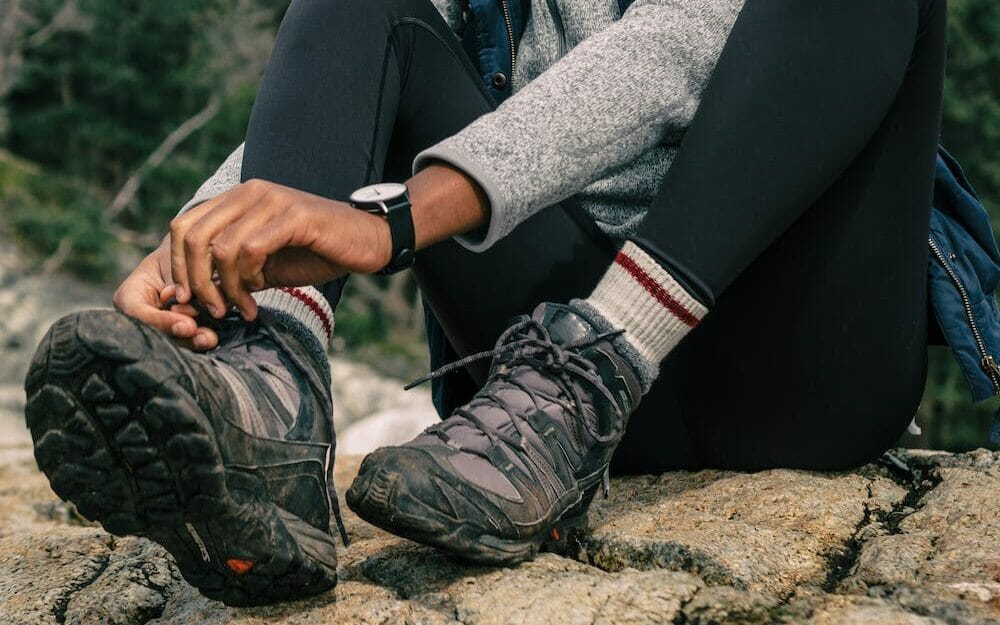How Much Toe Room In Hiking Boots? Room To Roam
The toe room in hiking boots is the amount of space between the end of the toes and the front of the boot. It is important to have the proper amount of toe room in hiking boots for several reasons which we’ll discuss later in this article. But what is the ideal toe room in hiking boots?
The amount of toe room in hiking boots depends on personal preference, the type of hiking you plan to do, and the fit of the boots.
As a general rule, there should be enough space in the toe box area to wiggle your toes comfortably, and your toes should not touch the front of the boots when you are standing or walking downhill.
You should also consider the type of socks you plan to wear while hiking, as thicker socks will require more toe room than thinner socks.

14 Best Hiking Boots For Men All Terrain in 2023
The article aims to educate readers on the importance of proper toe room for comfort, circulation, balance, and injury prevention, as well as to provide practical tips for finding the right fit.
Factors That Affect Toe Room In Hiking Boots
Proper toe room greatly enhances your comfort and enjoyment on the trail while minimizing the risk of foot injuries or blisters. So It is important to consider each of these factors when selecting hiking boots to ensure that you have the right amount of toe room for your foot shape, sock choice, lacing technique, and hiking conditions.
What Color Hiking Boots Should I Get
1. Boot Style and Design
Different hiking boots have varying styles and designs, and this significantly impacts the amount of room that they offer. For instance, boots that have a more tapered toe box may not provide enough space for your toes to move freely which leads to discomfort and even blisters.

On the other hand, boots that have a wider, more rounded toe box accommodates different foot shapes and sizes and provide adequate room for the toes to move. In my experience, I have also found that boots with a wider toe box tend to be more comfortable for me, as I have wider feet.
2. Foot Shape and Size
Foot shape and size also affect how much toe room you need in hiking boots. People with wider feet or long toes may require more room in the toe box to prevent their toes from being cramped or compressed.
It is important to ensure that the boots fit properly in the length and width of your foot. I have wider feet, and I have found that it is crucial to look for boots that have a wider toe box to prevent discomfort during hiking.
3. Sock Choice
The thickness and material of the socks you wear also influence the amount of room you need. Thicker socks take up more space in the boot, which requires a larger toe box. On the other hand, thinner socks may not require as much toe room.
How to Get Mildew Smell Out of Hiking Boots
4. Lacing Technique
Lacing your boots too tightly in the toe box reduces the amount of available space for your toes, leading to discomfort or pain. On the other hand, leaving the laces too loose also causes your foot to slide forward, hitting the front of the boot, which can be equally uncomfortable.
So i have found that experimenting with different lacing techniques and adjusting the tightness of my laces make a significant difference in how much toe room I need.

5. Terrain and Hiking Conditions
The type of terrain you will be hiking on and the length of your hike also affect how much toe room you need. For example, if you will be hiking downhill for an extended time, you may need more toe room to prevent your toes from sliding forward and hitting the front of the boot.
Consequences Of Having Inadequate Tow Room
Wearing hiking boots with inadequate toe room leads to a variety of consequences, including discomfort, blisters, and even toenail damage. When your toes are cramped in your hiking boots, your toes rub against the inside of the boot, leading to painful blisters or calluses.
How Often Should You Replace Your Hiking Boots?
If the boots are too tight around the toes, they also cause toenail damage, including bruising, blackening, or even loss of toenails. Over time, wearing hiking boots with inadequate toe room can also cause foot deformities, such as hammertoes or bunions, which can require medical treatment.
Therefore, it is essential to ensure that your hiking boots provide enough room for your toes to move comfortably to prevent any adverse consequences.
Benefits Of Having Adequate Toe Room
Having the proper amount of toe room in your hiking boots is essential for comfort, good circulation, balance, and injury prevention. It is important to consider the factors that affect the room and to take the time to measure and adjust your boots to ensure a proper fit.
1. Comfort
A proper toe room is essential for comfort. When hiking, your feet are subjected to a lot of stress and pressure, and having enough room for your toes to move and flex help prevent blisters, calluses, and other foot injuries. Having enough toe room also helps prevent your toes from being cramped and feeling uncomfortable, especially on long hikes.
2. Blood Circulation
If your boots are too tight in the toe box, they can constrict the blood flow in your feet, leading to discomfort, pain, and even injury. This is especially problematic in colder weather when circulation is already somewhat restricted.

Proper toe room helps you maintain good balance and stability on the trail. If your toes are crammed together, it is more difficult to maintain your balance and navigate rough terrain, leading to a higher risk of falls and injuries.
Having the right amount of toe room in your hiking boots also prevent your toenails from becoming bruised or falling off due to repeated impact with the front of the boot.
Best Cheap Waterproof Hiking Boots
Recommended Toe Room For Hiking Boots
It is also important to consider these factors and to try on different boots to ensure that you have the proper amount of toe room.
Toe Room for Downhill Hiking
For downhill hiking, it is recommended to have slightly more toe room in your boots. This is because your foot may slide forward in the boot when descending steep slopes, which can cause your toes to hit the front of the boot. Having enough room in the toe box can help prevent discomfort and blisters.
Toe Room for Uphill Hiking
For uphill hiking, you may be able to get away with slightly less toe room, as your foot may not slide forward as much. However, it is still important to have enough space in the toe box for your toes to move freely, as a snug fit can cause discomfort and pain over long periods.
Toe Room for Long-Distance Hiking
For long-distance hiking, it is especially important to have the right amount of toe room in your boots to prevent discomfort and injuries. It is recommended to have enough space in the toe box to accommodate any swelling that may occur during prolonged periods of hiking.
Toe Room for Different Types of Hiking Boots
The recommended toe room can vary depending on the type of hiking boots you are wearing. For example, lightweight trail running shoes may require less toe room than heavier backpacking boots, as they may provide less support and protection.


